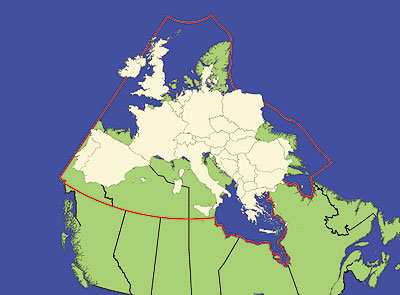Indeed, some people get panicked or over-hyped when they think about instant separation the day after a potential winning referendum. As a Quebeccer, I'll try and answer your questions to the best of my ability and with neutrality in mind, as always.
Quebec has a keen interest in Labrador, especially since the border is already contested and Quebec never recognized the Privy Council's decision. Other than that, the geographical status quo would be maintained: the Eastern Townships, even if highly populated by anglophones, remain majoritarily francophone. As for the East-West divide, the separatist government would likely use that as leverage, just like the Saint-Laurent waterway, to force Canada into cooperation.
As for the debt itself, it is a result of the Canadian Federal Government's decisions, which the Quebec government has no authority over, as such, Quebec is not legally forced to pay any part of it. Take for example, a young adult leaving his parents' house, he is not legally bound to pay his raisers' debt in any way. But for the sake of healthy bilateral relations, let's imagine Quebec accepts to take a part of it, which would likely be between 15 and 25% percent depending on the calculation method (population-based, GDP-based, Spending-based, etc.). But just as in interpersonal debt transfers, it also involves an asset transfer equal in proportional value to the debt percentage transfer. That said, Quebec could just aswell decide to nationalize any non-diplomatic foreign government-held propriety on its territory, such as CFBs, Federal Bridges, etc, without taking any debt. That'd be an ******* move, though, and bad for relations with its second economic partner.
Speaking of economic partnership, Quebec would probably refuse to give Canada (ON) a link to the maritimes, as that would mean cutting off Quebec from its most important economic partner, the US. As for the money, it would probably be a long transfer between the CAD and the "QCP?"(QuebeC Piastre, "piastre" being the most common slang for 1$ in Quebec) over the course of a decade or two. All currently living Quebecers would be granted both citizenships and subsequent generations would receive only the Quebec citizenship after separation has been fully completed (possible delay of 15-25 years). There is no doubt that monetary transfers would be gradually cut off during the separation, both inwards and outwards (respectively 60 and 40 billion, approx) and Quebec would have to make use of its new-found independence and proceed to some financial and structural clean up, (fighting corruption, fiscal evasion) as well as displacing some money from social programs to economic investment to make up for the 20 billion disparity.
Last but not least, Quebec's military, akin to its currency, would probably take decades before obtaining monopoly, as the first few years would probably be comparable to a protectorate (ie; British Dominion of Canada), followed by a strong integration in NORAD, and finally an autonomous self-defense force. Unlikely that it would join NATO, considering Quebeccers are mostly anti-militaristic (frig me...), lean rather in favour of Russia, and in disfavour of Turkey.
Oh, and the federal institutions in Quebec are manned by... Quebeccers. So the services would just be transferred to the Quebec government and it probably wouldn't affect much.
In any case, if Quebec were to seceed and the other Canadian nations to follow suit, I believe Canada would remain a strong historico-cultural heritage uniting "ex-canadians", akin to say, a German and a Belgian's attachment to Europe.
Inb4: I am not in favour of any political action, I simply observe and analyze. That's what I do.




